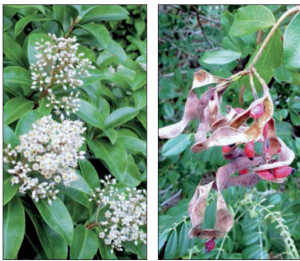
“I got rid of my lawn,” said self-identified plant-aholic Patricia Nolan. “I covered it with cardboard, mulch and began building soil. Now my yard is full of birds, bees and butterflies, all like little children.” Nolan was speaking before the lecture at the Key West Botanical Gardens given by Janice Duquesnel, a biological scientist from the Florida Park Service about planting the right plant to get a “Green Thumb Certification.” A grant provided money to educate nurseries and other plant sellers which plants to sell to create a bio-resource that is native.
“Don’t plant this exotic, plant the native ‘alter-natives,’” Duquesnel said, dividing the word into two parts. “Why is it better to use native species?” she asked. Natives provide small patches of habitat for Nolan’s “wildlife children” that frolic in her yard. They establish corridors in which wildlife travels. Birds, insects, mammals and butterflies readily find food in them. Just like human children, baby birds will eat what they have been fed in the nest by their parents and reject strange foods. Wildlife will use less water if its feeds on native plants. For the gardener, native plants take less maintenance and survive storms better. No replanting is necessary. Finally, planting native trees enhances the diversity of the landscape.
What is a native species? Duquesnel defines it as a species that came to the islands by natural dispersal, that is, from a bird or storm. A native is not defined by how long it has been in the location. The worst of the invasive species in the Florida Keys is the Brazilian pepper that supplies red peppercorns. It loves the climate and grows rampantly, taking over entire ecosystems of natives. Instead, plant crabwood with its bird feeding, small, red pumpkin-like seeds. Or plant blackbead. Anole lizards feed on the insects in its flower and then spread the flower’s pollen. This is one of the few instances recorded of a reptile pollinator. Instead of the voracious lead tree or women’s tongue, plant the weepy branches of the 15-foot tall Bahama strongback. Its fragrant nectar attracts all different kinds of butterflies. Duquesnel noticed 50 butterflies on one tree. Fiddlewood likes the open sun and smells like a gardenia with year-round racemes of white flowers. The umbrella tree is a Category I invasive, which could be replaced by the fast-growing 25-foot, paradise tree. Cinnamon bark has aromatic leaves that smell like cinnamon and were noted by the plant collector who accompanied Christopher Columbus. They attract the large Schaus’ swallowtail butterfly and can stun fish if the branches are thrown in the water. Scaevola is not native to the Keys. It can be replaced with seven-year apple, bay cedar, maten, joewood or the splendid marlberry, which some say smells like cookie dough. Some other seldom-used native trees that can add unique variety to the environment are white ironwood, Jamaica caper, wild tamarind, lancewood, inkwood, princewood, lignumvitae, satin leaf, blolly, pigeon plum, Jamaica dogwood, Florida boxwood, all of the stopper species and locustberry. The possibilities are many and the rewards are a plethora of local life taking advantage of the gardener’s “alter-natives.”
Key West Master Gardener Robin Robinson was a columnist for the Chicago Daily News and syndicated with Princeton Features. Her books include “Plants of Paradise” and “Roots, Rocks and Rain: Native Trees of the Florida Keys.” For more information, visit keywestgardenclub.com.
